Jiayu Chen
Eric
Advancing Multimodal Reasoning: From Optimized Cold Start to Staged Reinforcement Learning
Jun 04, 2025



Abstract:Inspired by the remarkable reasoning capabilities of Deepseek-R1 in complex textual tasks, many works attempt to incentivize similar capabilities in Multimodal Large Language Models (MLLMs) by directly applying reinforcement learning (RL). However, they still struggle to activate complex reasoning. In this paper, rather than examining multimodal RL in isolation, we delve into current training pipelines and identify three crucial phenomena: 1) Effective cold start initialization is critical for enhancing MLLM reasoning. Intriguingly, we find that initializing with carefully selected text data alone can lead to performance surpassing many recent multimodal reasoning models, even before multimodal RL. 2) Standard GRPO applied to multimodal RL suffers from gradient stagnation, which degrades training stability and performance. 3) Subsequent text-only RL training, following the multimodal RL phase, further enhances multimodal reasoning. This staged training approach effectively balances perceptual grounding and cognitive reasoning development. By incorporating the above insights and addressing multimodal RL issues, we introduce ReVisual-R1, achieving a new state-of-the-art among open-source 7B MLLMs on challenging benchmarks including MathVerse, MathVision, WeMath, LogicVista, DynaMath, and challenging AIME2024 and AIME2025.
Policy-Driven World Model Adaptation for Robust Offline Model-based Reinforcement Learning
May 19, 2025Abstract:Offline reinforcement learning (RL) offers a powerful paradigm for data-driven control. Compared to model-free approaches, offline model-based RL (MBRL) explicitly learns a world model from a static dataset and uses it as a surrogate simulator, improving data efficiency and enabling potential generalization beyond the dataset support. However, most existing offline MBRL methods follow a two-stage training procedure: first learning a world model by maximizing the likelihood of the observed transitions, then optimizing a policy to maximize its expected return under the learned model. This objective mismatch results in a world model that is not necessarily optimized for effective policy learning. Moreover, we observe that policies learned via offline MBRL often lack robustness during deployment, and small adversarial noise in the environment can lead to significant performance degradation. To address these, we propose a framework that dynamically adapts the world model alongside the policy under a unified learning objective aimed at improving robustness. At the core of our method is a maximin optimization problem, which we solve by innovatively utilizing Stackelberg learning dynamics. We provide theoretical analysis to support our design and introduce computationally efficient implementations. We benchmark our algorithm on twelve noisy D4RL MuJoCo tasks and three stochastic Tokamak Control tasks, demonstrating its state-of-the-art performance.
FedHQ: Hybrid Runtime Quantization for Federated Learning
May 17, 2025Abstract:Federated Learning (FL) is a decentralized model training approach that preserves data privacy but struggles with low efficiency. Quantization, a powerful training optimization technique, has been widely explored for integration into FL. However, many studies fail to consider the distinct performance attribution between particular quantization strategies, such as post-training quantization (PTQ) or quantization-aware training (QAT). As a result, existing FL quantization methods rely solely on either PTQ or QAT, optimizing for speed or accuracy while compromising the other. To efficiently accelerate FL and maintain distributed convergence accuracy across various FL settings, this paper proposes a hybrid quantitation approach combining PTQ and QAT for FL systems. We conduct case studies to validate the effectiveness of using hybrid quantization in FL. To solve the difficulty of modeling speed and accuracy caused by device and data heterogeneity, we propose a hardware-related analysis and data-distribution-related analysis to help identify the trade-off boundaries for strategy selection. Based on these, we proposed a novel framework named FedHQ to automatically adopt optimal hybrid strategy allocation for FL systems. Specifically, FedHQ develops a coarse-grained global initialization and fine-grained ML-based adjustment to ensure efficiency and robustness. Experiments show that FedHQ achieves up to 2.47x times training acceleration and up to 11.15% accuracy improvement and negligible extra overhead.
Hysteresis-Aware Neural Network Modeling and Whole-Body Reinforcement Learning Control of Soft Robots
Apr 18, 2025Abstract:Soft robots exhibit inherent compliance and safety, which makes them particularly suitable for applications requiring direct physical interaction with humans, such as surgical procedures. However, their nonlinear and hysteretic behavior, resulting from the properties of soft materials, presents substantial challenges for accurate modeling and control. In this study, we present a soft robotic system designed for surgical applications and propose a hysteresis-aware whole-body neural network model that accurately captures and predicts the soft robot's whole-body motion, including its hysteretic behavior. Building upon the high-precision dynamic model, we construct a highly parallel simulation environment for soft robot control and apply an on-policy reinforcement learning algorithm to efficiently train whole-body motion control strategies. Based on the trained control policy, we developed a soft robotic system for surgical applications and validated it through phantom-based laser ablation experiments in a physical environment. The results demonstrate that the hysteresis-aware modeling reduces the Mean Squared Error (MSE) by 84.95 percent compared to traditional modeling methods. The deployed control algorithm achieved a trajectory tracking error ranging from 0.126 to 0.250 mm on the real soft robot, highlighting its precision in real-world conditions. The proposed method showed strong performance in phantom-based surgical experiments and demonstrates its potential for complex scenarios, including future real-world clinical applications.
Rack Position Optimization in Large-Scale Heterogeneous Data Centers
Mar 31, 2025Abstract:As rapidly growing AI computational demands accelerate the need for new hardware installation and maintenance, this work explores optimal data center resource management by balancing operational efficiency with fault tolerance through strategic rack positioning considering diverse resources and locations. Traditional mixed-integer programming (MIP) approaches often struggle with scalability, while heuristic methods may result in significant sub-optimality. To address these issues, this paper presents a novel two-tier optimization framework using a high-level deep reinforcement learning (DRL) model to guide a low-level gradient-based heuristic for local search. The high-level DRL agent employs Leader Reward for optimal rack type ordering, and the low-level heuristic efficiently maps racks to positions, minimizing movement counts and ensuring fault-tolerant resource distribution. This approach allows scalability to over 100,000 positions and 100 rack types. Our method outperformed the gradient-based heuristic by 7\% on average and the MIP solver by over 30\% in objective value. It achieved a 100\% success rate versus MIP's 97.5\% (within a 20-minute limit), completing in just 2 minutes compared to MIP's 1630 minutes (i.e., almost 4 orders of magnitude improvement). Unlike the MIP solver, which showed performance variability under time constraints and high penalties, our algorithm consistently delivered stable, efficient results - an essential feature for large-scale data center management.
MoQa: Rethinking MoE Quantization with Multi-stage Data-model Distribution Awareness
Mar 27, 2025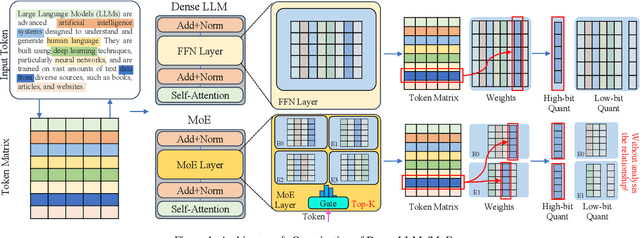
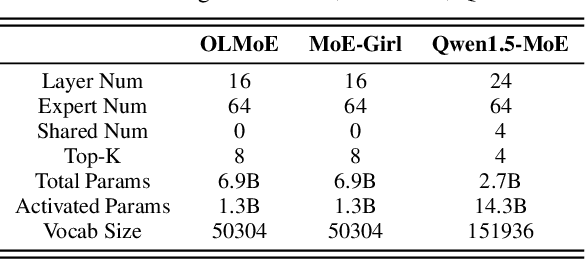
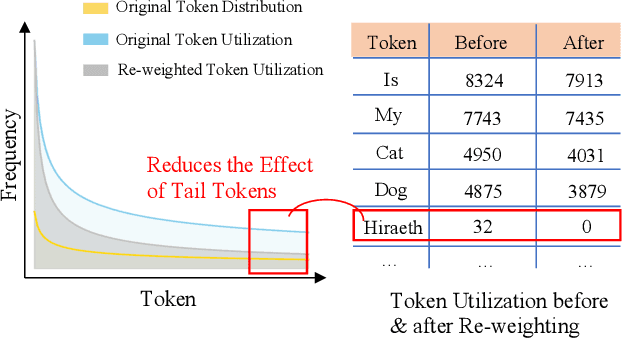
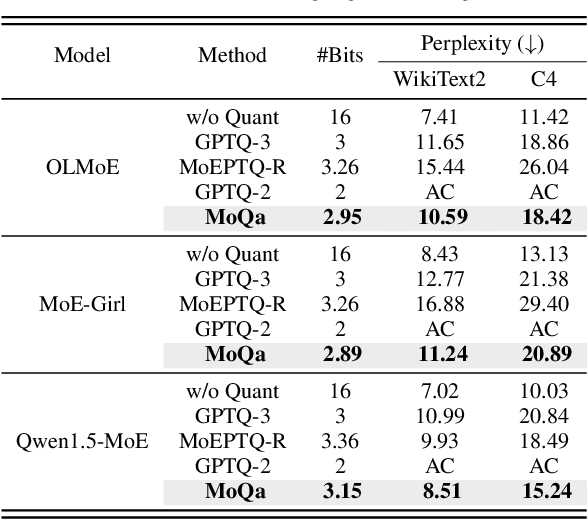
Abstract:With the advances in artificial intelligence, Mix-of-Experts (MoE) has become the main form of Large Language Models (LLMs), and its demand for model compression is increasing. Quantization is an effective method that not only compresses the models but also significantly accelerates their performance. Existing quantization methods have gradually shifted the focus from parameter scaling to the analysis of data distributions. However, their analysis is designed for dense LLMs and relies on the simple one-model-all-data mapping, which is unsuitable for MoEs. This paper proposes a new quantization framework called MoQa. MoQa decouples the data-model distribution complexity of MoEs in multiple analysis stages, quantitively revealing the dynamics during sparse data activation, data-parameter mapping, and inter-expert correlations. Based on these, MoQa identifies particular experts' and parameters' significance with optimal data-model distribution awareness and proposes a series of fine-grained mix-quantization strategies adaptive to various data activation and expert combination scenarios. Moreover, MoQa discusses the limitations of existing quantization and analyzes the impact of each stage analysis, showing novel insights for MoE quantization. Experiments show that MoQa achieves a 1.69~2.18 perplexity decrease in language modeling tasks and a 1.58%~8.91% accuracy improvement in zero-shot inference tasks. We believe MoQa will play a role in future MoE construction, optimization, and compression.
Threshold Neuron: A Brain-inspired Artificial Neuron for Efficient On-device Inference
Dec 18, 2024Abstract:Enhancing the computational efficiency of on-device Deep Neural Networks (DNNs) remains a significant challengein mobile and edge computing. As we aim to execute increasingly complex tasks with constrained computational resources, much of the research has focused on compressing neural network structures and optimizing systems. Although many studies have focused on compressing neural network structures and parameters or optimizing underlying systems, there has been limited attention on optimizing the fundamental building blocks of neural networks: the neurons. In this study, we deliberate on a simple but important research question: Can we design artificial neurons that offer greater efficiency than the traditional neuron paradigm? Inspired by the threshold mechanisms and the excitation-inhibition balance observed in biological neurons, we propose a novel artificial neuron model, Threshold Neurons. Using Threshold Neurons, we can construct neural networks similar to those with traditional artificial neurons, while significantly reducing hardware implementation complexity. Our extensive experiments validate the effectiveness of neural networks utilizing Threshold Neurons, achieving substantial power savings of 7.51x to 8.19x and area savings of 3.89x to 4.33x at the kernel level, with minimal loss in precision. Furthermore, FPGA-based implementations of these networks demonstrate 2.52x power savings and 1.75x speed enhancements at the system level. The source code will be made available upon publication.
What Matters in Learning A Zero-Shot Sim-to-Real RL Policy for Quadrotor Control? A Comprehensive Study
Dec 17, 2024Abstract:Executing precise and agile flight maneuvers is critical for quadrotors in various applications. Traditional quadrotor control approaches are limited by their reliance on flat trajectories or time-consuming optimization, which restricts their flexibility. Recently, RL-based policy has emerged as a promising alternative due to its ability to directly map observations to actions, reducing the need for detailed system knowledge and actuation constraints. However, a significant challenge remains in bridging the sim-to-real gap, where RL-based policies often experience instability when deployed in real world. In this paper, we investigate key factors for learning robust RL-based control policies that are capable of zero-shot deployment in real-world quadrotors. We identify five critical factors and we develop a PPO-based training framework named SimpleFlight, which integrates these five techniques. We validate the efficacy of SimpleFlight on Crazyflie quadrotor, demonstrating that it achieves more than a 50% reduction in trajectory tracking error compared to state-of-the-art RL baselines, and achieves 70% improvement over the traditional MPC. The policy derived by SimpleFlight consistently excels across both smooth polynominal trajectories and challenging infeasible zigzag trajectories on small thrust-to-weight quadrotors. In contrast, baseline methods struggle with high-speed or infeasible trajectories. To support further research and reproducibility, we integrate SimpleFlight into a GPU-based simulator Omnidrones and provide open-source access to the code and model checkpoints. We hope SimpleFlight will offer valuable insights for advancing RL-based quadrotor control. For more details, visit our project website at https://sites.google.com/view/simpleflight/.
Multi-UAV Behavior-based Formation with Static and Dynamic Obstacles Avoidance via Reinforcement Learning
Oct 24, 2024



Abstract:Formation control of multiple Unmanned Aerial Vehicles (UAVs) is vital for practical applications. This paper tackles the task of behavior-based UAV formation while avoiding static and dynamic obstacles during directed flight. We present a two-stage reinforcement learning (RL) training pipeline to tackle the challenge of multi-objective optimization, large exploration spaces, and the sim-to-real gap. The first stage searches in a simplified scenario for a linear utility function that balances all task objectives simultaneously, whereas the second stage applies the utility function in complex scenarios, utilizing curriculum learning to navigate large exploration spaces. Additionally, we apply an attention-based observation encoder to enhance formation maintenance and manage varying obstacle quantity. Experiments in simulation and real world demonstrate that our method outperforms planning-based and RL-based baselines regarding collision-free rate and formation maintenance in scenarios with static, dynamic, and mixed obstacles.
Bayes Adaptive Monte Carlo Tree Search for Offline Model-based Reinforcement Learning
Oct 15, 2024
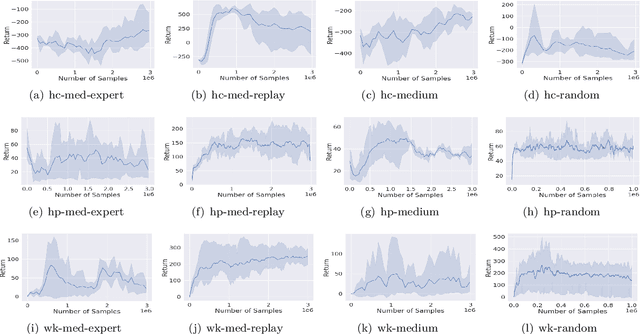


Abstract:Offline reinforcement learning (RL) is a powerful approach for data-driven decision-making and control. Compared to model-free methods, offline model-based reinforcement learning (MBRL) explicitly learns world models from a static dataset and uses them as surrogate simulators, improving the data efficiency and enabling the learned policy to potentially generalize beyond the dataset support. However, there could be various MDPs that behave identically on the offline dataset and so dealing with the uncertainty about the true MDP can be challenging. In this paper, we propose modeling offline MBRL as a Bayes Adaptive Markov Decision Process (BAMDP), which is a principled framework for addressing model uncertainty. We further introduce a novel Bayes Adaptive Monte-Carlo planning algorithm capable of solving BAMDPs in continuous state and action spaces with stochastic transitions. This planning process is based on Monte Carlo Tree Search and can be integrated into offline MBRL as a policy improvement operator in policy iteration. Our ``RL + Search" framework follows in the footsteps of superhuman AIs like AlphaZero, improving on current offline MBRL methods by incorporating more computation input. The proposed algorithm significantly outperforms state-of-the-art model-based and model-free offline RL methods on twelve D4RL MuJoCo benchmark tasks and three target tracking tasks in a challenging, stochastic tokamak control simulator.
 Add to Chrome
Add to Chrome Add to Firefox
Add to Firefox Add to Edge
Add to Edge